
Aaron Rizzer and Belle Marie Belizaire savor a special moment. Their laughter and unspoken understanding fill the space, a quiet testament to the bond that needs no words, only the pleasure of each other’s company and one of their favorite entrees.*
Author: J H McIntosh

Fried chicken, mashed potatoes, burgers, pies, and Sunday-supper warmth.
The heart of American cuisine lies in its diversity—fried chicken, mashed potatoes, burgers, and pies all share space at the table. Food travelers like Anthony Bourdain have framed American cooking as a living record of many traditions, blended into something uniquely our own.
It’s nostalgia served warm—pot roast, meatloaf, mac and cheese—the meals that built families and fueled dreams. When you crave familiarity, American fare is where you go to remember who you are. At RestaurantsOpedia, we spotlight spots that do it right: scratch gravies, slow braises, flaky crusts, and hospitality that feels like home.
What defines “American”? Seasonal comfort, immigrant roots, and a love of generous sides. Think chicken-fried steak, skillet cornbread, and Sunday pies that taste like memory.
Tip: Look for house-made sides—if the small things sing, the mains usually soar.
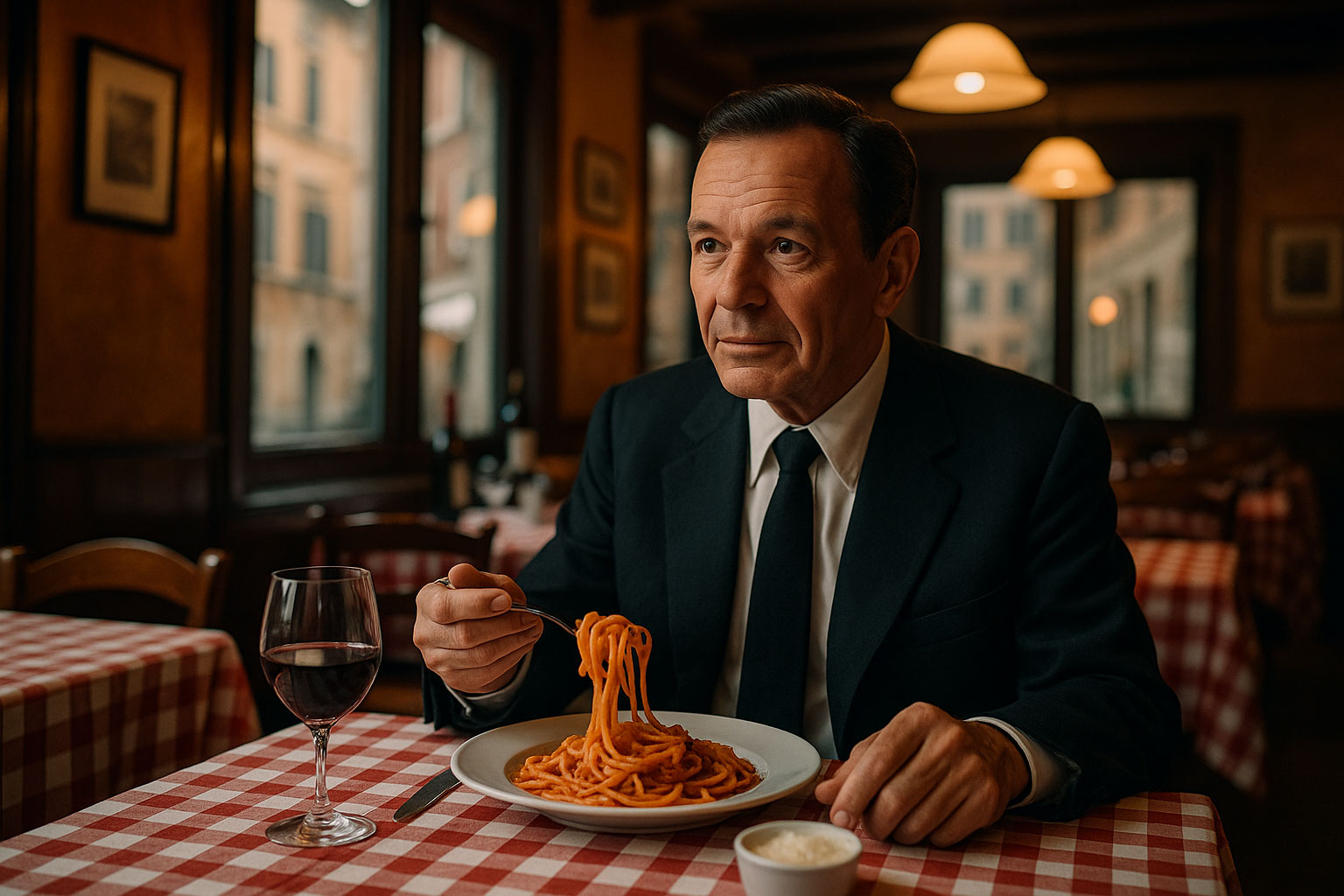
Pasta, pizza, risotto, and the art of simple ingredients done perfectly.
When comfort calls, Italian cuisine answers with soul. From a perfectly sauced spaghetti to a bubbling lasagna, Italian food embodies love on a plate. Its universal appeal lies in simple ingredients—fresh tomatoes, olive oil, basil, and cheese—elevated by generations of passion.
Julia Roberts popularized the joy of eating pasta in Eat Pray Love, and Frank Sinatra was known to dine at Patsy’s in New York for veal parmigiana. Whether you’re craving Neapolitan pizza, creamy risotto, or handmade ravioli, Italian cuisine is less about indulgence and more about connection—to flavor, family, and the moment.
Italian cooking celebrates restraint: a few excellent ingredients treated with respect. Expect seasonal vegetables, quality olive oil, and sauces that kiss, not smother, the pasta. The result is food that feels both generous and light on its feet.
Tip: “Al dente” isn’t a trend—it’s texture. Sauces should finish with the pasta in the pan.

Al pastor, mole, fajitas, nachos, and salsas that sing.
Few cuisines capture the joy of eating like Mexican and Tex-Mex. The bright flavors, fiery salsas, and fresh herbs deliver a feast for the senses. Anthony Bourdain often praised authentic Mexican cooking as one of the world’s most underrated cuisines.
From tacos al pastor to enchiladas drenched in mole, every dish tells a story of heritage and heart. Tex-Mex adds an American twist with smoky fajitas, cheesy nachos, and sizzling burritos. Together they satisfy both spice seekers and comfort food lovers. For many, taco night isn’t just dinner—it’s a celebration of color, creativity, and community.
Think balance: acid from lime and tomatillos, heat from chiles, freshness from cilantro and onion, depth from roasted tomatoes and long-simmered meats. Handmade tortillas and a just-made salsa are the soul of the experience.

Dim sum, wok fire, regional spice, and centuries of culinary craft.
A cornerstone of global dining, Chinese cuisine balances flavor, texture, and tradition like few others. From dim sum to kung pao chicken, every dish embodies harmony—sweet, sour, salty, bitter, and umami. Michelle Yeoh has called Chinese food her ultimate comfort, evoking memories of long family meals.
With regional specialties like Sichuan’s spice and Cantonese’s subtlety, Chinese cuisine offers endless variety. It’s equally at home in a takeout box or a fine dining setting, where chefs reinterpret ancient recipes for modern palates. A plate of fried rice or soup dumplings might seem simple, but within it lies centuries of artistry.
Chinese cooking is built on balance and technique: knife work for texture, precise heat for wok hei (the breath of the wok), and sauces that layer aromatics like ginger, garlic, scallion, and fermented pastes. Family-style sharing keeps the table dynamic and generous.
Tip: For dim sum, arrive early; flag fresh steamer carts and order in rounds.
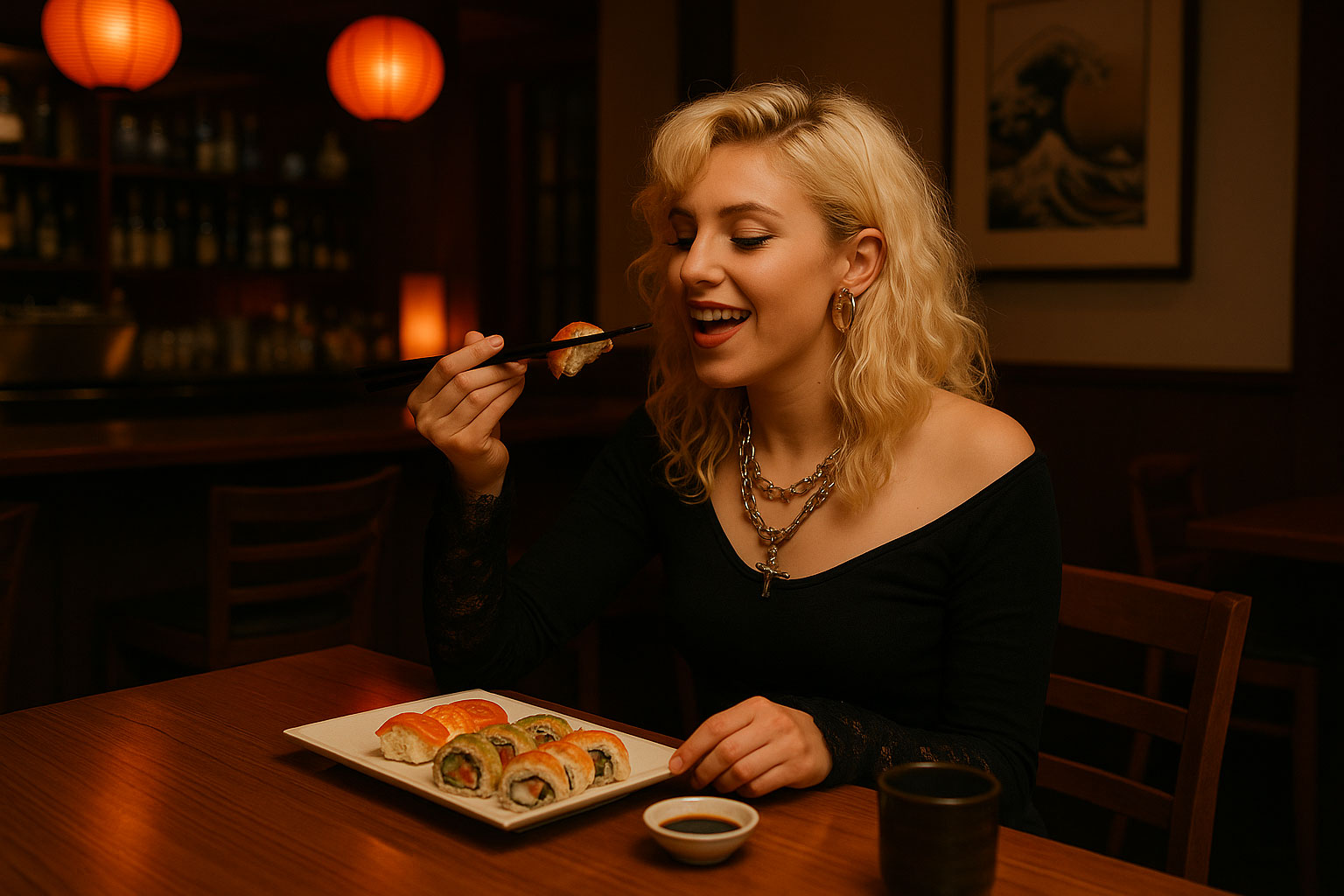
Sushi, ramen, tempura, and the art of seasonality.
Precision and purity define Japanese dining. Each meal feels like an act of mindfulness—sushi that melts on the tongue, ramen rich with broth, or tempura that crackles with lightness. Chefs like Nobu Matsuhisa helped elevate traditions to international art, drawing fans worldwide.
The emphasis on freshness and seasonality turns dining into ritual—not rush. From Kyoto’s kaiseki to Tokyo’s sushi bars, Japanese cuisine teaches that simplicity, when done perfectly, can be divine.
Japanese cooking prizes clarity: pristine ingredients, knife work for texture, and precise heat. Dashi (kombu & bonito) builds umami; rice anchors the meal; pickles cleanse the palate. Presentation matters—harmony of color, season, and form.
Tip: Trust the counter—ask what’s best today. Seasonality (shun) is everything.

Smash patties, diner classics, gourmet stacks, and plant-powered icons.
Few foods capture the American spirit like a burger—humble, hearty, and endlessly adaptable. Whether stacked high with toppings or served plain and perfect, burgers are the great equalizer. Barack Obama famously called Five Guys his favorite burger joint, proving even presidents appreciate a good patty.
From diner classics to gourmet reinventions with wagyu beef and truffle aioli, the burger is timeless. It’s the taste of summer, road trips, and simple satisfaction—always best with a side of fries and good company.
Great burgers balance fat, heat, and texture. The magic lives in the grind (brisket/chuck blends), the sear (hot flat-top or flame-kissed grill), salt at the right moment, and a bun that holds without stealing the show. Sauce is the handshake—friendly, not overpowering.
Tip: If the fries are hand-cut and the buns are toasted to order, you’re in good hands.
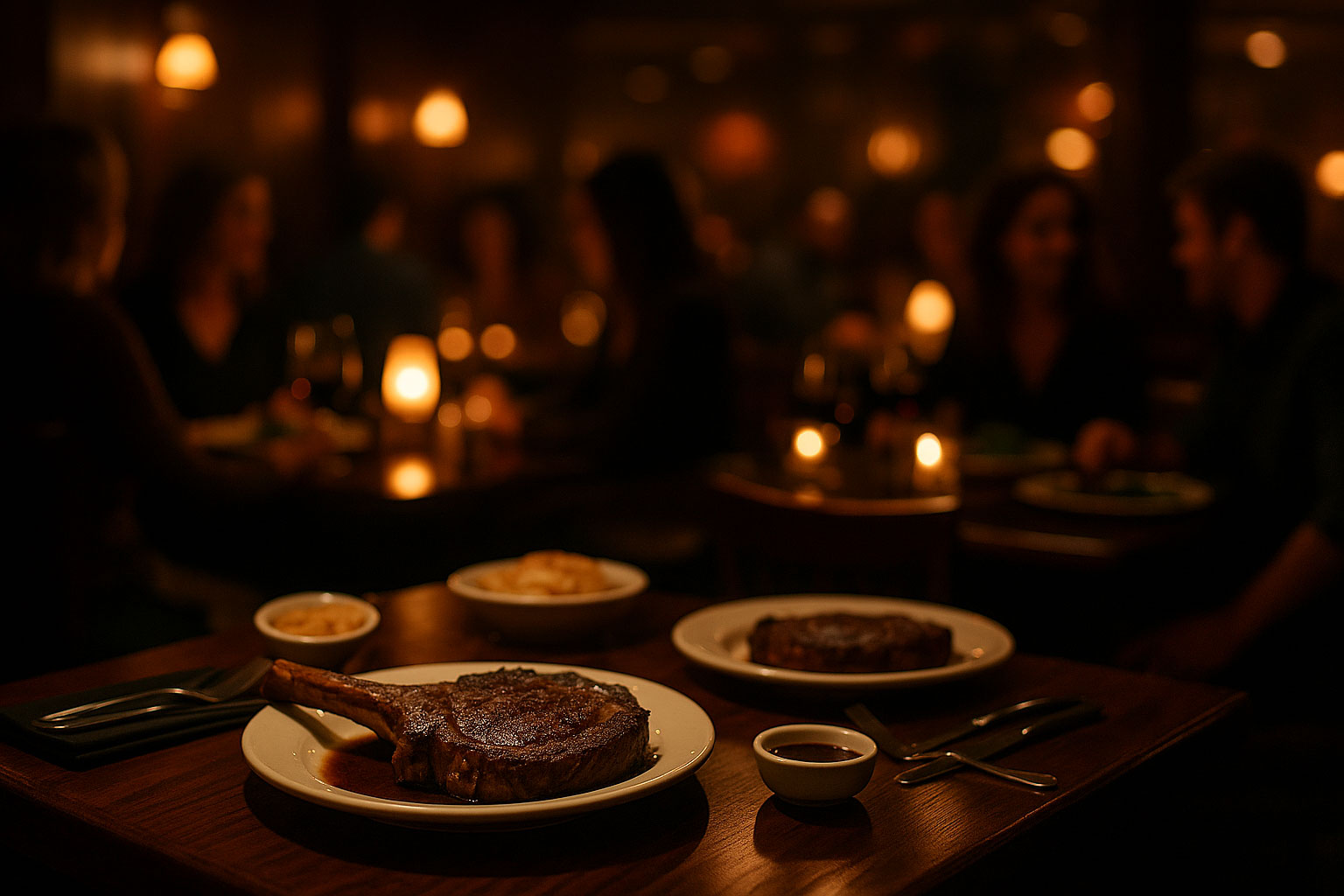
Aged beef, deep sears, rich sides, and quiet ceremony.
There’s something primal and deeply satisfying about cutting into a perfectly cooked steak. The aroma, the sizzle, the anticipation—it all builds to that first, savory bite. Winston Churchill was known to insist on steak and a fine claret as his dinner of choice.
Today’s steakhouses continue that tradition of indulgence, pairing aged beef with bold wines and rich sides like creamed spinach or loaded potatoes. Whether you prefer a ribeye charred to perfection or a filet mignon kissed with butter, a steakhouse meal remains the quintessential expression of hearty luxury.
Great steak is about sourcing and technique: well-marbled beef (Prime/Choice or wagyu), aggressive heat for a crust, and proper rest for juiciness. A sprinkle of flaky salt at service and a hot plate to keep it warm—small rituals, big payoff.
Tip: Hot plates matter—if offered, say yes. It keeps the crust singing.

Memphis ribs, Texas brisket, Carolina pork, Kansas City sauces, and beyond.
Smoked low and slow, BBQ is equal parts craft and culture. Whether it’s Memphis ribs, Texas brisket, or Carolina pulled pork, the magic lies in patience and smoke. Country legend Dolly Parton has often shared her love of Southern BBQ, “the flavor of home.”
Each region adds its own fingerprint—tangy vinegar sauces, sweet molasses glazes, or dry rubs heavy with spice. BBQ invites conversation, community, and messy fingers. It’s food meant to be shared—because great smoke, like great stories, takes time.
BBQ is transformation: tough cuts become tender through hours of low heat and clean smoke. Wood choice sets the tone—hickory (classic), oak (balanced), mesquite (assertive), pecan/apple/cherry (sweet, mild). Look for a mahogany bark, rosy smoke ring, and meat that bites clean, not mushy.
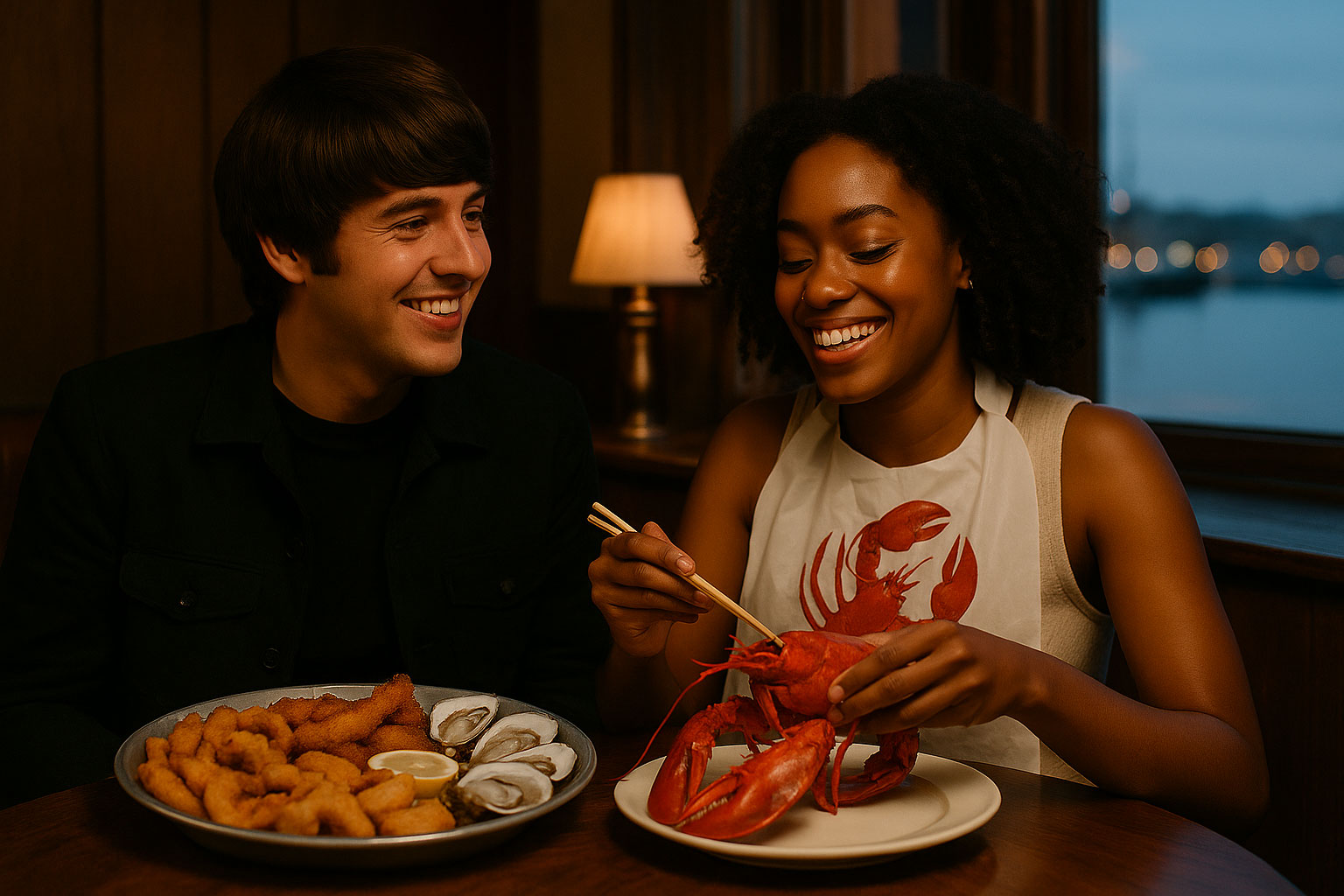
Lobster, salmon, scallops, raw bars, and bright coastal cooking.
When you crave the ocean’s bounty, seafood offers freshness few other foods can match. Whether it’s buttery lobster, grilled salmon, or delicate scallops, the appeal is universal. Chef Jacques Pépin calls seafood “the art of restraint”—letting the ingredient speak for itself.
From Maine to Monterey, seafood isn’t just sustenance; it’s celebration. Paul McCartney, a lifelong advocate for sustainable eating, often praises seafood’s lighter footprint when responsibly sourced. From fish tacos to crab bisque, each bite brings the sea a little closer.
Great seafood is about freshness, tenderness, and clean, bright seasoning. Citrus, herbs, good olive oil, and a light hand let pristine fish and shellfish shine. Look for firm flesh, sweet aroma (never “fishy”), and respectful cooking temps.
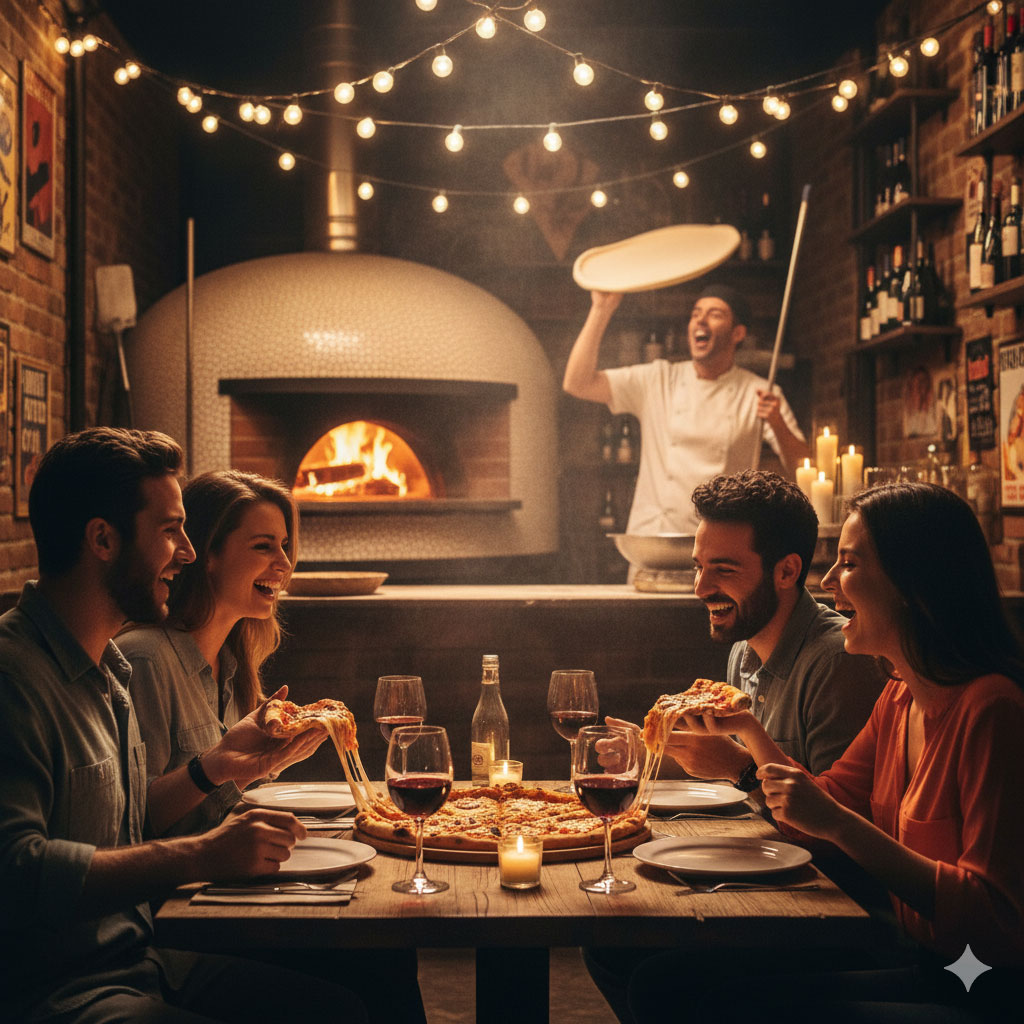
Neapolitan blister, NYC fold, tavern crackle, and share-every-slice vibes.
Pizza is passion—molten cheese, crisp crust, and endless possibilities. From New York slices to Neapolitan masterpieces, it’s one of the world’s most beloved foods. Oprah Winfrey once joked she could “never break up with pizza,” and millions agree.
Whether wood-fired or delivered, pizza brings people together—for game nights, birthdays, and lazy Sundays. It’s not just food; it’s an edible ritual, hot from the oven and shared from the heart.
Great pizza lives at the intersection of dough, heat, and balance. Fermented dough for flavor and chew; high heat for leopard-spotted blister; toppings that complement—not bury—the crust and sauce. A good pie eats well from first slice to last bite of cornicione.
Tip: If the shop brags about flour, fermentation time, and oven temp, you’re in expert hands.
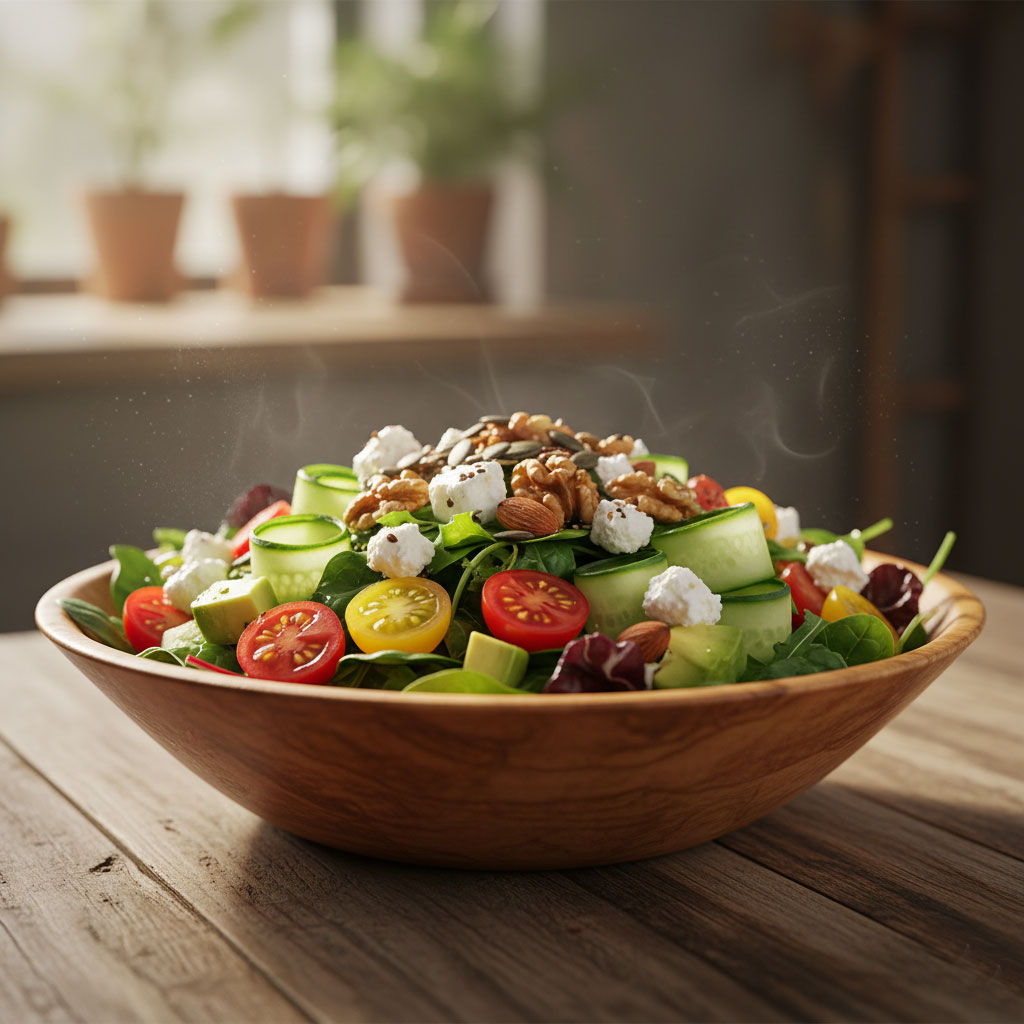
Greens, grains, fruits, nuts, and dressings that make simplicity shine.
Fresh, crisp, and colorful—salads celebrate life’s lighter side. They’re versatile enough to start a meal or stand alone as one. Actress Jennifer Aniston famously inspired a viral “Friends salad” known for its wholesome simplicity.
The best salads mix contrast—sweet fruits with savory cheese, crunchy nuts with tender greens. With global influences like Greek, Cobb, and Caesar, there’s a version for every craving. Eating a salad feels like giving your body a bouquet—beautiful, nourishing, and full of life.
Salads are all about texture and balance. Fresh greens form the base, fruits and vegetables add vibrancy, protein provides structure, and the dressing ties everything together. The best salads are not side thoughts—they’re composed plates of color, crunch, and contrast.
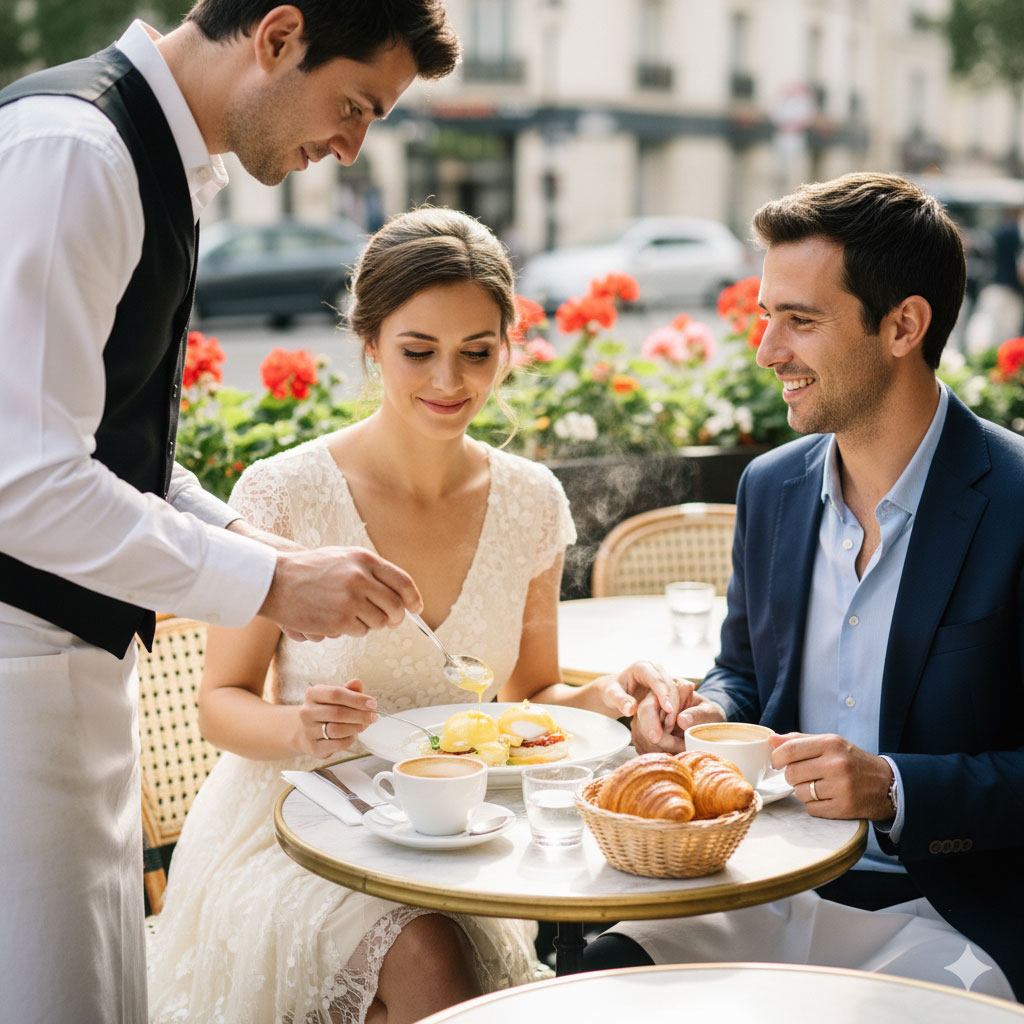
Bistros & grands maisons: sauces, terroir wines, bread, and pastry arts.
French cooking is the art of turning simple ingredients into ceremony. The first crackle of a baguette, the gloss of butter melting into a pan, the perfume of shallots and wine—everything builds toward sauces that speak their own language.
From bistros serving steak frites and coq au vin to grand maisons plating duck confit, bouillabaisse, or a cloud-light soufflé, French cuisine marries craft with comfort. Burgundy and Bordeaux meet the table like old friends; Champagne keeps the conversation bright. Finish with crème brûlée’s shatter or a ripe cheese course and you understand the point: terroir, technique, and time, gathered on a plate. Whether rustic or refined, a French meal is less about fuss and more about grace—an elegant reminder that pleasure is worth the trouble.
French cuisine balances technique and restraint: precise knife work, careful heat, and sauces that frame—not bury—the main ingredient. Bistro fare feels convivial and hearty; haute cuisine is polished and contemplative. Either way, hospitality and pacing are part of the experience.

Pancakes & waffles, eggs & bacon, coffee & quiet beginnings.
Breakfast is where comfort greets the day. The hiss of bacon, the pop of a toaster, and the scent of coffee brewing form a morning symphony that’s both humble and hopeful. Across America, diners and cafés treat breakfast as ritual—whether it’s buttermilk pancakes stacked high, a golden omelet folded with cheese, or biscuits blanketed in gravy.
In France, it’s lighter—a croissant and café au lait; in the South, it’s grits and country ham; in New York, it’s a bagel still warm from the oven. Whatever the plate, breakfast carries a quiet promise: to start over, to nourish, to take a moment before the rush. It’s not just the first meal of the day—it’s the reminder that life is best savored one bite, one sip, one sunrise at a time.
Great breakfasts balance warmth, texture, and timing: hot-from-the-griddle cakes, crisp bacon, just-set eggs, and coffee poured at the peak of aroma. House-made syrups, real butter, and fresh-baked breads separate the memorable from the routine.
Tip: A warm plate matters—keeps eggs silky and pancakes cloud-soft.

Neon glow, drive-thru hum, fries & shakes at midnight.
When the world quiets down and hunger speaks louder than reason, fast food answers the call. Neon signs flicker through the night, drive-thru speakers hum, and sizzling grills promise comfort on demand. It’s not fine dining—it’s freedom in a paper bag.
From golden fries and double cheeseburgers to spicy chicken sandwiches and midnight tacos, fast food is the shared language of road trips, study breaks, and after-hours laughter. Late at night, when most kitchens are closed, these bright oases stay alive—offering warmth, salt, and familiarity to shift workers, travelers, and dreamers chasing the next sunrise.
Whether it’s nostalgia or necessity, the late-night combo reminds us that sometimes the simplest meal, eaten under fluorescent light, can taste like salvation.
Fast food thrives on speed, consistency, and craveable salt-fat-heat. Expect hot fries, crisp chicken, charred patties, fizzy sodas, and soft-serve swirls. The late-night crowd skews casual and grateful—students, service workers, touring bands, and long-haul drivers refueling in minutes.
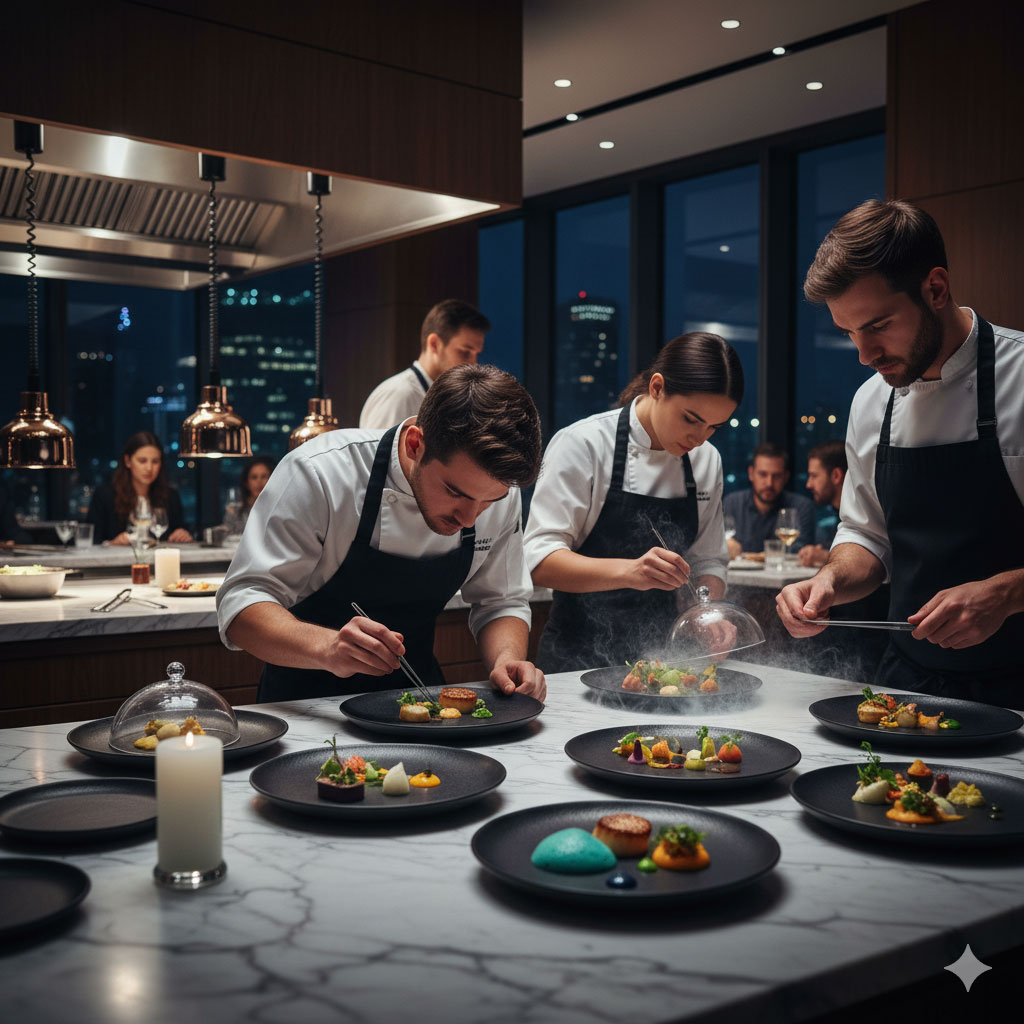
Avant-garde technique, global mashups, and edible theater.
Modern chefs are rewriting culinary rules, and Neo Cuisine is where innovation thrives. It fuses flavors, techniques, and cultures—think avocado foam, edible flowers, and nitrogen-cooled desserts. Chef Grant Achatz of Chicago’s Alinea helped redefine the experience, turning dining into performance art.
Neo Cuisine isn’t about showing off; it’s about surprise—evoking wonder with every bite. It’s where curiosity meets creativity, and the plate becomes a playground.
Expect boundary-pushing ideas: familiar flavors in unfamiliar forms, courses that engage all senses, and service paced like a story arc. Neo kitchens blend craft with chemistry, but the goal stays simple—delicious food that sparks emotion.
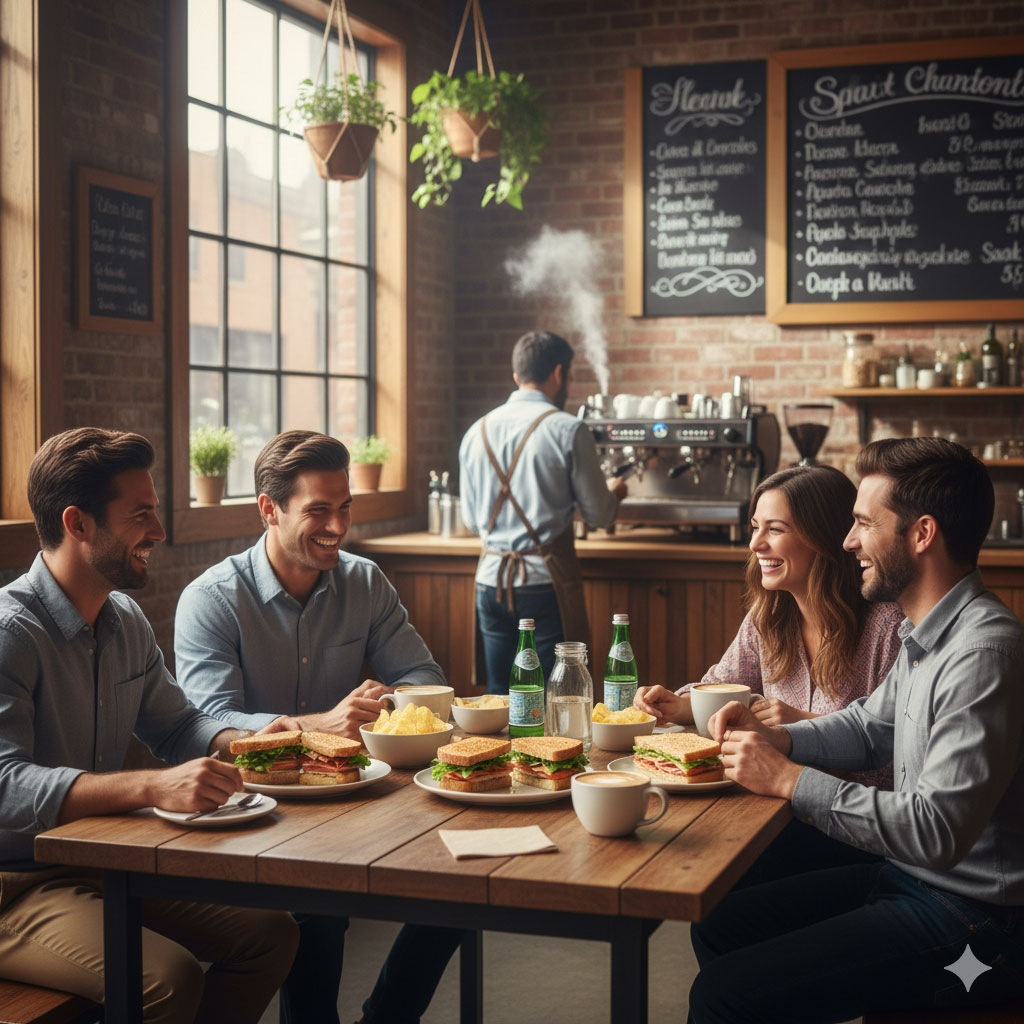
BLTs, Cubanos, Reubens, Bahn mì, and the art of bread + filling + balance.
A good sandwich is proof that simplicity can be sublime. Two slices of bread become a canvas for endless creativity—from a BLT to a Cubano or an elegant croque monsieur. James Beard once quipped, “Too few people understand a good sandwich.” The best versions balance flavor, texture, and heart.
Whether wrapped for a picnic or pressed in a café, sandwiches turn convenience into comfort, one bite at a time. At RestaurantsOpedia, we hunt for shops that bake their bread, cure their meats, pickle their veg, and whip their own spreads.
Structure matters: sturdy bread, a moisture barrier (butter/cheese/greens), well-seasoned fillings, and smart layering so every bite has crunch, richness, acidity, and freshness. Warm sandwiches crave a proper toast or press; cold ones shine with peak produce and crisp lettuce.

Broths, chowders, bisques, and stews that soothe and restore.
Warm, soothing, and deeply personal, soup is food that heals. From chicken noodle to clam chowder, every spoonful tells a story of care. Chef Ina Garten once said, “You can tell a lot about someone by the soup they make.”
Cultures around the world have their versions—French onion with melted cheese, Vietnamese pho fragrant with herbs, or New England chowder thick with cream. Soup comforts the soul and invites reflection. It’s the meal you make when words aren’t enough.
Great soup begins with a thoughtful base—clear stock or creamy velouté—built from bones, aromatics, and time. The magic is balance: body from collagen or cream, brightness from acid (lemon, vinegar), and lift from herbs. Garnishes add texture: croutons, herbs, scallions, a swirl of cream, or a drizzle of chili oil.
Tip: A good broth should set softly when chilled—hello, natural gelatin.

Buffalo heat, sweet smoke, lemon-pepper swagger, and game-night energy.
When the craving hits, few things satisfy like chicken wings—crispy, saucy, and unapologetically messy. From classic Buffalo to honey barbecue, they embody communal joy. NBA legend Michael Jordan once claimed that wings were his go-to post-game meal.
Beyond flavor, wings bring energy and camaraderie—perfect for parties, pubs, and cheering crowds. A platter of wings isn’t fancy, but it’s freedom—bold, finger-licking, and fun.
Great wings are about texture + sauce balance: shatter-crisp skin, juicy meat, and a glaze that clings without sogging the bite. Double-frying or high-heat convection gives that prized crunch; finishing toss determines shine and heat.

24/7 counters, bottomless mugs, pancakes off the plate, and stories at booth #3.
Truck stops are America’s unsung sanctuaries—part rest haven, part refueling station, and part confessional for the highway-worn. The glow of fluorescent lights cuts through the night, beckoning travelers, truckers, and wanderers alike to pull off the asphalt and find a plate, a seat, and a story.
Inside, the coffee is strong enough to wake the dead, the pancakes hang off the plate, and the waitress calls everyone “hon.” The menu never really changes—eggs any style, open-faced sandwiches, pie by the slice—but that’s the point. Consistency is its own comfort when the miles blur together.
These are waypoints for working America—places where dawn crews, night drivers, and families on the move cross paths. Expect big portions, quick pours, friendly service, and a griddle seasoned by a thousand breakfasts.

Hand-dipped truffles, old-school sundaes, artisan breads, and patisserie craft.
There’s a special kind of joy that lives behind glass displays of frosting, glaze, and sugar—the scent of fresh bread mingling with chocolate, the soft hum of freezers churning cream. It’s childhood and celebration rolled into one.
Sweet shops tempt with hand-dipped truffles and nostalgic candies; ice cream parlors swirl art into cones and sundaes; bakeries rise before dawn to craft croissants, éclairs, and cakes that turn ordinary days into occasions. Whether it’s a soda fountain crowned with whipped cream or a modern patisserie layering pistachio mousse and mirror glaze, sweetness is a craft—and a kindness.
Great sweets balance texture, temperature, and aroma: crisp shells over silky centers, warm bakes beside cool scoops, and real vanilla, cacao, butter, and spice. The best counters feel like a small celebration—one bite at a time.
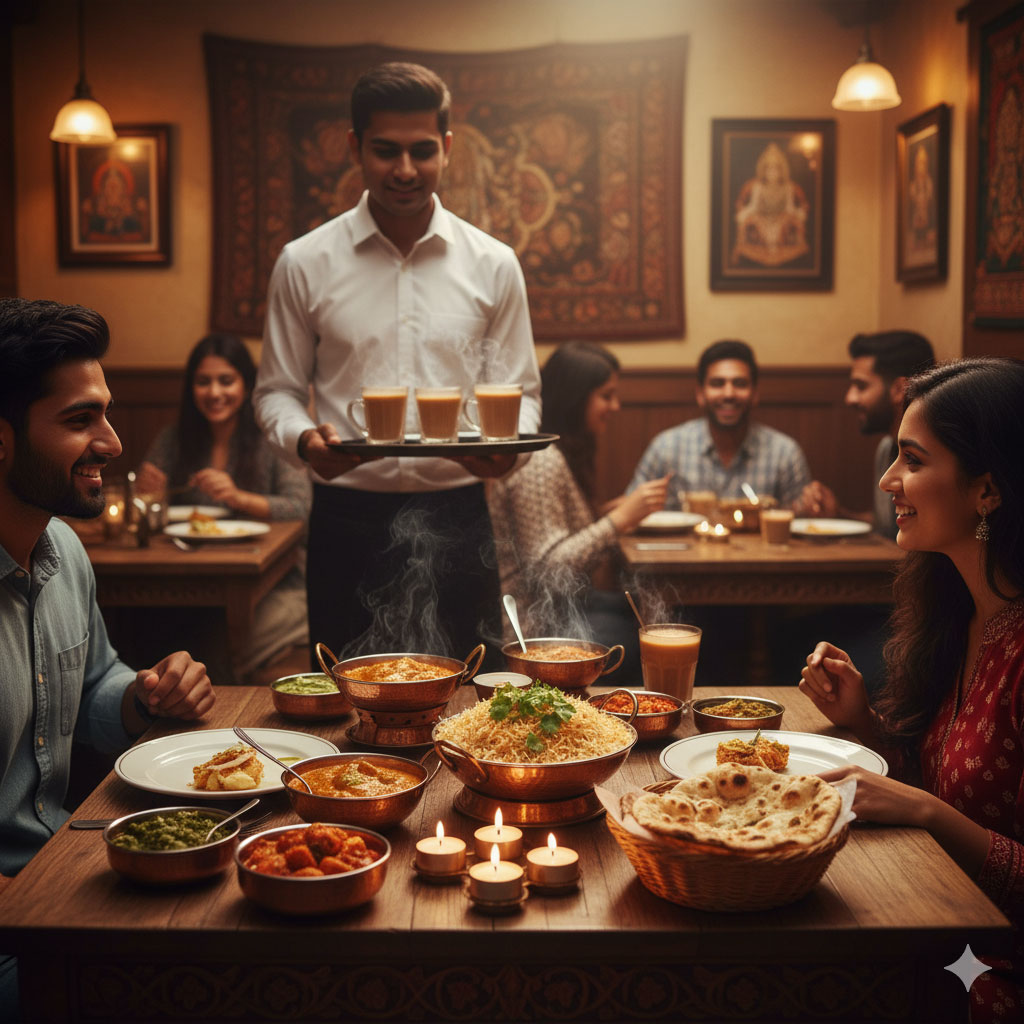
Tandoor grills, slow-simmered curries, chaat zest, and generous vegetarian menus.
Indian cuisine dazzles the senses—vivid colors, bold spices, and complex layers of flavor. From tikka masala to dosas, each dish reflects centuries of tradition and artistry. Commentators often connect Indian food to wellness, including its roots in Ayurveda.
The balance of sweet, sour, salty, and heat creates harmony not just in taste but in spirit. With its abundant vegetarian options and rich curries, Indian food invites you to slow down, savor, and awaken every sense.
Indian cooking layers whole spices (cardamom, cumin, mustard seed) with ground masalas, onions, ginger, garlic, and tomatoes. Techniques range from tandoor roasting to slow dum braising. Fresh herbs and a splash of yogurt, lime, or ghee finish the dish with lift and sheen.

Korean tacos, Thai pasta, Filipino adobo—tradition meets imagination.
Asian Fusion celebrates culinary imagination — a conversation between cultures. You might find Korean bulgogi tacos or Thai basil pasta. Celebrity chef Roy Choi popularized the concept with his Korean-Mexican Kogi food trucks, inspiring a generation of adventurous eaters.
Whether it’s Vietnamese pho, Filipino adobo, or Malaysian satay, Asian Fusion keeps tradition alive while creating something entirely new. It’s the modern palate’s passport to flavor.
Asian Fusion blends classic techniques with global ingredients, where boundaries blur and creativity thrives. Think wok-fired noodles tossed with Italian herbs, or sushi rolls wrapped in plantain instead of seaweed. Each dish tells a story of migration, innovation, and taste without borders.

Olive oil, lemon, herbs, grilled seafood — nourishment for body and spirit.
Light, vibrant, and wholesome — Mediterranean cuisine is the definition of balance. Olive oil, lemon, herbs, and grilled meats or seafood form its backbone. Jennifer Lopez has credited the Mediterranean diet for her energy and glow.
From Greek souvlaki to Lebanese hummus, it’s food that nourishes both body and spirit. Each dish reminds us that health and pleasure can — and should — coexist beautifully.
The Mediterranean table unites three continents — Europe, Asia, and Africa — through shared flavors of olive oil, citrus, grains, and fresh vegetables. It’s not just a diet; it’s a way of life emphasizing community, simplicity, and joy. Meals are meant to be savored, not rushed, shared with friends over laughter and sea breezes.
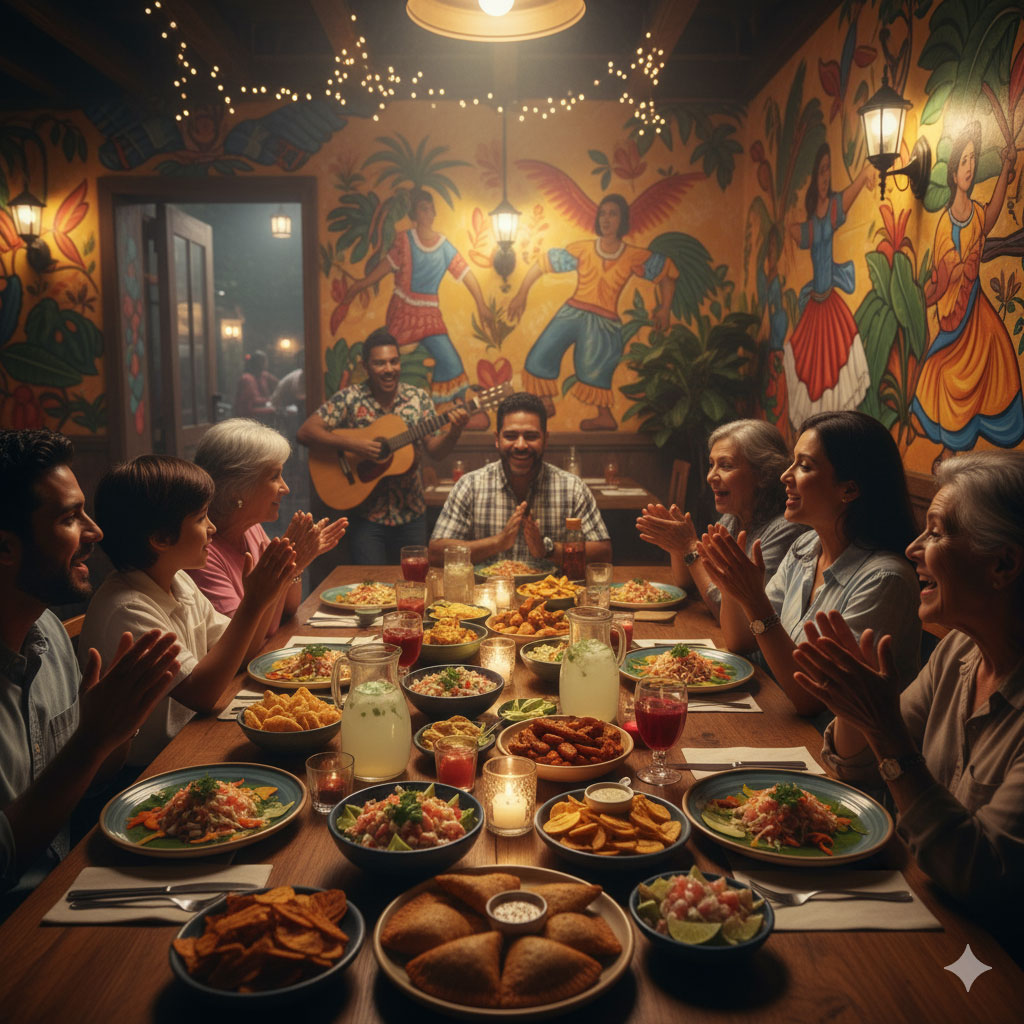
Ceviche tang, empanada comfort, smoky parrillas, and feijoada feasts.
From the tang of ceviche to the comfort of empanadas, Latin American food is a dance of color and spice—joyful, soulful, and unabashedly generous. Chef José Andrés has called Latin cuisine “the story of celebration through struggle,” honoring its roots and resilience.
Every bite—from Argentine steak to Brazilian feijoada—connects passion with heritage. Latin food invites you to eat with both hands and your heart.
A vast mosaic from Mexico to Patagonia: corn, beans, chiles, tropical fruit, and Andean tubers meet open-fire grilling, clay-pot stews, and coastal citrus cures. Expect brightness (lime, naranja agria), smoke (parrilla, asado), and texture (masa, yuca, plantain).
Tip: For ceviche, ask when the fish was prepped; the brightest versions are mixed to order.
*Aaron Rizzer, (a/k/a Professor Remember) and Belle Marie Belizaire are fictional characters in the four Jimmy Rogers Chronicles novels written by J H McIntosh.
“Can’t Stop It,” the first novel is a coming of age/murder mystery where teenager Jimmy Rogers is in a battle to break from his Father’s belief “Life is a cruel joke, barely worth living”.
If Jimmy loses this battle, he will take his own life and the deaths of his best friend David Perkins and David’s girlfriend Cathy Carlson will go unsolved.
Aaron is the founder of Professor Remember’s Roadhouse and Bakery Café, where he first met Belle the day she applied for the hostess job at Remembers.
For more information about the characters and events in “Can’t Stop It” go here. Download any of the 50 original songs that highlight events in the stories here.
If you own or manage a restaurant, you already know that flavor travels fast—but in today’s digital world, it needs the right destination. That’s where RestaurantsOpedia comes in. We’re not just another directory; we’re a vertical—a focused hub where people already craving great eateries come to explore, learn, and decide where to eat next. Advertising here means you’re speaking directly to an audience that’s already hungry for you.
Even better, RestaurantsOpedia is part of a growing family of more than twenty restaurant-focused “Opedia” sites, including BurgersOpedia, PizzaOpedia, and WingsOpedia. Together, they form a connected network of food lovers who cross paths from one craving to the next. Someone enjoying a burger on Monday might be searching for tacos on Tuesday!
That’s the power of a vertical network—reaching the right people at the right time, across the flavors they already love. Advertising on RestaurantsOpedia helps your restaurant get discovered, shared, and remembered.
List Your Restaurant
Aaron Rizzer and Belle Marie Belizaire savor a special moment. Their laughter and unspoken understanding fill the space, a quiet testament to the bond that needs no words, only the comfort of each other’s company and one of their favorite entrees.*
Author: J H McIntosh

Fried chicken, mashed potatoes, burgers, pies, and Sunday-supper warmth.
The heart of American cuisine lies in its diversity—fried chicken, mashed potatoes, burgers, and pies all share space at the table. Food travelers like Anthony Bourdain have framed American cooking as a living record of many traditions, blended into something uniquely our own.
It’s nostalgia served warm—pot roast, meatloaf, mac and cheese—the meals that built families and fueled dreams. When you crave familiarity, American fare is where you go to remember who you are. At RestaurantsOpedia, we spotlight spots that do it right: scratch gravies, slow braises, flaky crusts, and hospitality that feels like home.
What defines “American”? Seasonal comfort, immigrant roots, and a love of generous sides. Think chicken-fried steak, skillet cornbread, and Sunday pies that taste like memory.
Tip: Look for house-made sides—if the small things sing, the mains usually soar.

Pasta, pizza, risotto, and the art of simple ingredients done perfectly.
When comfort calls, Italian cuisine answers with soul. From a perfectly sauced spaghetti to a bubbling lasagna, Italian food embodies love on a plate. Its universal appeal lies in simple ingredients—fresh tomatoes, olive oil, basil, and cheese—elevated by generations of passion.
Julia Roberts popularized the joy of eating pasta in Eat Pray Love, and Frank Sinatra was known to dine at Patsy’s in New York for veal parmigiana. Whether you’re craving Neapolitan pizza, creamy risotto, or handmade ravioli, Italian cuisine is less about indulgence and more about connection—to flavor, family, and the moment.
Italian cooking celebrates restraint: a few excellent ingredients treated with respect. Expect seasonal vegetables, quality olive oil, and sauces that kiss, not smother, the pasta. The result is food that feels both generous and light on its feet.
Tip: “Al dente” isn’t a trend—it’s texture. Sauces should finish with the pasta in the pan.

Al pastor, mole, fajitas, nachos, and salsas that sing.
Few cuisines capture the joy of eating like Mexican and Tex-Mex. The bright flavors, fiery salsas, and fresh herbs deliver a feast for the senses. Anthony Bourdain often praised authentic Mexican cooking as one of the world’s most underrated cuisines.
From tacos al pastor to enchiladas drenched in mole, every dish tells a story of heritage and heart. Tex-Mex adds an American twist with smoky fajitas, cheesy nachos, and sizzling burritos. Together they satisfy both spice seekers and comfort food lovers. For many, taco night isn’t just dinner—it’s a celebration of color, creativity, and community.
Think balance: acid from lime and tomatillos, heat from chiles, freshness from cilantro and onion, depth from roasted tomatoes and long-simmered meats. Handmade tortillas and a just-made salsa are the soul of the experience.

Dim sum, wok fire, regional spice, and centuries of culinary craft.
A cornerstone of global dining, Chinese cuisine balances flavor, texture, and tradition like few others. From dim sum to kung pao chicken, every dish embodies harmony—sweet, sour, salty, bitter, and umami. Michelle Yeoh has called Chinese food her ultimate comfort, evoking memories of long family meals.
With regional specialties like Sichuan’s spice and Cantonese’s subtlety, Chinese cuisine offers endless variety. It’s equally at home in a takeout box or a fine dining setting, where chefs reinterpret ancient recipes for modern palates. A plate of fried rice or soup dumplings might seem simple, but within it lies centuries of artistry.
Chinese cooking is built on balance and technique: knife work for texture, precise heat for wok hei (the breath of the wok), and sauces that layer aromatics like ginger, garlic, scallion, and fermented pastes. Family-style sharing keeps the table dynamic and generous.
Tip: For dim sum, arrive early; flag fresh steamer carts and order in rounds.

Sushi, ramen, tempura, and the art of seasonality.
Precision and purity define Japanese dining. Each meal feels like an act of mindfulness—sushi that melts on the tongue, ramen rich with broth, or tempura that crackles with lightness. Chefs like Nobu Matsuhisa helped elevate traditions to international art, drawing fans worldwide.
The emphasis on freshness and seasonality turns dining into ritual—not rush. From Kyoto’s kaiseki to Tokyo’s sushi bars, Japanese cuisine teaches that simplicity, when done perfectly, can be divine.
Japanese cooking prizes clarity: pristine ingredients, knife work for texture, and precise heat. Dashi (kombu & bonito) builds umami; rice anchors the meal; pickles cleanse the palate. Presentation matters—harmony of color, season, and form.
Tip: Trust the counter—ask what’s best today. Seasonality (shun) is everything.

Smash patties, diner classics, gourmet stacks, and plant-powered icons.
Few foods capture the American spirit like a burger—humble, hearty, and endlessly adaptable. Whether stacked high with toppings or served plain and perfect, burgers are the great equalizer. Barack Obama famously called Five Guys his favorite burger joint, proving even presidents appreciate a good patty.
From diner classics to gourmet reinventions with wagyu beef and truffle aioli, the burger is timeless. It’s the taste of summer, road trips, and simple satisfaction—always best with a side of fries and good company.
Great burgers balance fat, heat, and texture. The magic lives in the grind (brisket/chuck blends), the sear (hot flat-top or flame-kissed grill), salt at the right moment, and a bun that holds without stealing the show. Sauce is the handshake—friendly, not overpowering.
Tip: If the fries are hand-cut and the buns are toasted to order, you’re in good hands.

Aged beef, deep sears, rich sides, and quiet ceremony.
There’s something primal and deeply satisfying about cutting into a perfectly cooked steak. The aroma, the sizzle, the anticipation—it all builds to that first, savory bite. Winston Churchill was known to insist on steak and a fine claret as his dinner of choice.
Today’s steakhouses continue that tradition of indulgence, pairing aged beef with bold wines and rich sides like creamed spinach or loaded potatoes. Whether you prefer a ribeye charred to perfection or a filet mignon kissed with butter, a steakhouse meal remains the quintessential expression of hearty luxury.
Great steak is about sourcing and technique: well-marbled beef (Prime/Choice or wagyu), aggressive heat for a crust, and proper rest for juiciness. A sprinkle of flaky salt at service and a hot plate to keep it warm—small rituals, big payoff.
Tip: Hot plates matter—if offered, say yes. It keeps the crust singing.

Memphis ribs, Texas brisket, Carolina pork, Kansas City sauces, and beyond.
Smoked low and slow, BBQ is equal parts craft and culture. Whether it’s Memphis ribs, Texas brisket, or Carolina pulled pork, the magic lies in patience and smoke. Country legend Dolly Parton has often shared her love of Southern BBQ, “the flavor of home.”
Each region adds its own fingerprint—tangy vinegar sauces, sweet molasses glazes, or dry rubs heavy with spice. BBQ invites conversation, community, and messy fingers. It’s food meant to be shared—because great smoke, like great stories, takes time.
BBQ is transformation: tough cuts become tender through hours of low heat and clean smoke. Wood choice sets the tone—hickory (classic), oak (balanced), mesquite (assertive), pecan/apple/cherry (sweet, mild). Look for a mahogany bark, rosy smoke ring, and meat that bites clean, not mushy.

Lobster, salmon, scallops, raw bars, and bright coastal cooking.
When you crave the ocean’s bounty, seafood offers freshness few other foods can match. Whether it’s buttery lobster, grilled salmon, or delicate scallops, the appeal is universal. Chef Jacques Pépin calls seafood “the art of restraint”—letting the ingredient speak for itself.
From Maine to Monterey, seafood isn’t just sustenance; it’s celebration. Paul McCartney, a lifelong advocate for sustainable eating, often praises seafood’s lighter footprint when responsibly sourced. From fish tacos to crab bisque, each bite brings the sea a little closer.
Great seafood is about freshness, tenderness, and clean, bright seasoning. Citrus, herbs, good olive oil, and a light hand let pristine fish and shellfish shine. Look for firm flesh, sweet aroma (never “fishy”), and respectful cooking temps.

Neapolitan blister, NYC fold, tavern crackle, and share-every-slice vibes.
Pizza is passion—molten cheese, crisp crust, and endless possibilities. From New York slices to Neapolitan masterpieces, it’s one of the world’s most beloved foods. Oprah Winfrey once joked she could “never break up with pizza,” and millions agree.
Whether wood-fired or delivered, pizza brings people together—for game nights, birthdays, and lazy Sundays. It’s not just food; it’s an edible ritual, hot from the oven and shared from the heart.
Great pizza lives at the intersection of dough, heat, and balance. Fermented dough for flavor and chew; high heat for leopard-spotted blister; toppings that complement—not bury—the crust and sauce. A good pie eats well from first slice to last bite of cornicione.
Tip: If the shop brags about flour, fermentation time, and oven temp, you’re in expert hands.

Greens, grains, fruits, nuts, and dressings that make simplicity shine.
Fresh, crisp, and colorful—salads celebrate life’s lighter side. They’re versatile enough to start a meal or stand alone as one. Actress Jennifer Aniston famously inspired a viral “Friends salad” known for its wholesome simplicity.
The best salads mix contrast—sweet fruits with savory cheese, crunchy nuts with tender greens. With global influences like Greek, Cobb, and Caesar, there’s a version for every craving. Eating a salad feels like giving your body a bouquet—beautiful, nourishing, and full of life.
Salads are all about texture and balance. Fresh greens form the base, fruits and vegetables add vibrancy, protein provides structure, and the dressing ties everything together. The best salads are not side thoughts—they’re composed plates of color, crunch, and contrast.

Bistros & grands maisons: sauces, terroir wines, bread, and pastry arts.
French cooking is the art of turning simple ingredients into ceremony. The first crackle of a baguette, the gloss of butter melting into a pan, the perfume of shallots and wine—everything builds toward sauces that speak their own language.
From bistros serving steak frites and coq au vin to grand maisons plating duck confit, bouillabaisse, or a cloud-light soufflé, French cuisine marries craft with comfort. Burgundy and Bordeaux meet the table like old friends; Champagne keeps the conversation bright. Finish with crème brûlée’s shatter or a ripe cheese course and you understand the point: terroir, technique, and time, gathered on a plate. Whether rustic or refined, a French meal is less about fuss and more about grace—an elegant reminder that pleasure is worth the trouble.
French cuisine balances technique and restraint: precise knife work, careful heat, and sauces that frame—not bury—the main ingredient. Bistro fare feels convivial and hearty; haute cuisine is polished and contemplative. Either way, hospitality and pacing are part of the experience.

Pancakes & waffles, eggs & bacon, coffee & quiet beginnings.
Breakfast is where comfort greets the day. The hiss of bacon, the pop of a toaster, and the scent of coffee brewing form a morning symphony that’s both humble and hopeful. Across America, diners and cafés treat breakfast as ritual—whether it’s buttermilk pancakes stacked high, a golden omelet folded with cheese, or biscuits blanketed in gravy.
In France, it’s lighter—a croissant and café au lait; in the South, it’s grits and country ham; in New York, it’s a bagel still warm from the oven. Whatever the plate, breakfast carries a quiet promise: to start over, to nourish, to take a moment before the rush. It’s not just the first meal of the day—it’s the reminder that life is best savored one bite, one sip, one sunrise at a time.
Great breakfasts balance warmth, texture, and timing: hot-from-the-griddle cakes, crisp bacon, just-set eggs, and coffee poured at the peak of aroma. House-made syrups, real butter, and fresh-baked breads separate the memorable from the routine.
Tip: A warm plate matters—keeps eggs silky and pancakes cloud-soft.

Neon glow, drive-thru hum, fries & shakes at midnight.
When the world quiets down and hunger speaks louder than reason, fast food answers the call. Neon signs flicker through the night, drive-thru speakers hum, and sizzling grills promise comfort on demand. It’s not fine dining—it’s freedom in a paper bag.
From golden fries and double cheeseburgers to spicy chicken sandwiches and midnight tacos, fast food is the shared language of road trips, study breaks, and after-hours laughter. Late at night, when most kitchens are closed, these bright oases stay alive—offering warmth, salt, and familiarity to shift workers, travelers, and dreamers chasing the next sunrise.
Whether it’s nostalgia or necessity, the late-night combo reminds us that sometimes the simplest meal, eaten under fluorescent light, can taste like salvation.
Fast food thrives on speed, consistency, and craveable salt-fat-heat. Expect hot fries, crisp chicken, charred patties, fizzy sodas, and soft-serve swirls. The late-night crowd skews casual and grateful—students, service workers, touring bands, and long-haul drivers refueling in minutes.

Avant-garde technique, global mashups, and edible theater.
Modern chefs are rewriting culinary rules, and Neo Cuisine is where innovation thrives. It fuses flavors, techniques, and cultures—think avocado foam, edible flowers, and nitrogen-cooled desserts. Chef Grant Achatz of Chicago’s Alinea helped redefine the experience, turning dining into performance art.
Neo Cuisine isn’t about showing off; it’s about surprise—evoking wonder with every bite. It’s where curiosity meets creativity, and the plate becomes a playground.
Expect boundary-pushing ideas: familiar flavors in unfamiliar forms, courses that engage all senses, and service paced like a story arc. Neo kitchens blend craft with chemistry, but the goal stays simple—delicious food that sparks emotion.

BLTs, Cubanos, Reubens, Bahn mì, and the art of bread + filling + balance.
A good sandwich is proof that simplicity can be sublime. Two slices of bread become a canvas for endless creativity—from a BLT to a Cubano or an elegant croque monsieur. James Beard once quipped, “Too few people understand a good sandwich.” The best versions balance flavor, texture, and heart.
Whether wrapped for a picnic or pressed in a café, sandwiches turn convenience into comfort, one bite at a time. At RestaurantsOpedia, we hunt for shops that bake their bread, cure their meats, pickle their veg, and whip their own spreads.
Structure matters: sturdy bread, a moisture barrier (butter/cheese/greens), well-seasoned fillings, and smart layering so every bite has crunch, richness, acidity, and freshness. Warm sandwiches crave a proper toast or press; cold ones shine with peak produce and crisp lettuce.

Broths, chowders, bisques, and stews that soothe and restore.
Warm, soothing, and deeply personal, soup is food that heals. From chicken noodle to clam chowder, every spoonful tells a story of care. Chef Ina Garten once said, “You can tell a lot about someone by the soup they make.”
Cultures around the world have their versions—French onion with melted cheese, Vietnamese pho fragrant with herbs, or New England chowder thick with cream. Soup comforts the soul and invites reflection. It’s the meal you make when words aren’t enough.
Great soup begins with a thoughtful base—clear stock or creamy velouté—built from bones, aromatics, and time. The magic is balance: body from collagen or cream, brightness from acid (lemon, vinegar), and lift from herbs. Garnishes add texture: croutons, herbs, scallions, a swirl of cream, or a drizzle of chili oil.
Tip: A good broth should set softly when chilled—hello, natural gelatin.

Buffalo heat, sweet smoke, lemon-pepper swagger, and game-night energy.
When the craving hits, few things satisfy like chicken wings—crispy, saucy, and unapologetically messy. From classic Buffalo to honey barbecue, they embody communal joy. NBA legend Michael Jordan once claimed that wings were his go-to post-game meal.
Beyond flavor, wings bring energy and camaraderie—perfect for parties, pubs, and cheering crowds. A platter of wings isn’t fancy, but it’s freedom—bold, finger-licking, and fun.
Great wings are about texture + sauce balance: shatter-crisp skin, juicy meat, and a glaze that clings without sogging the bite. Double-frying or high-heat convection gives that prized crunch; finishing toss determines shine and heat.

24/7 counters, bottomless mugs, pancakes off the plate, and stories at booth #3.
Truck stops are America’s unsung sanctuaries—part rest haven, part refueling station, and part confessional for the highway-worn. The glow of fluorescent lights cuts through the night, beckoning travelers, truckers, and wanderers alike to pull off the asphalt and find a plate, a seat, and a story.
Inside, the coffee is strong enough to wake the dead, the pancakes hang off the plate, and the waitress calls everyone “hon.” The menu never really changes—eggs any style, open-faced sandwiches, pie by the slice—but that’s the point. Consistency is its own comfort when the miles blur together.
These are waypoints for working America—places where dawn crews, night drivers, and families on the move cross paths. Expect big portions, quick pours, friendly service, and a griddle seasoned by a thousand breakfasts.

Hand-dipped truffles, old-school sundaes, artisan breads, and patisserie craft.
There’s a special kind of joy that lives behind glass displays of frosting, glaze, and sugar—the scent of fresh bread mingling with chocolate, the soft hum of freezers churning cream. It’s childhood and celebration rolled into one.
Sweet shops tempt with hand-dipped truffles and nostalgic candies; ice cream parlors swirl art into cones and sundaes; bakeries rise before dawn to craft croissants, éclairs, and cakes that turn ordinary days into occasions. Whether it’s a soda fountain crowned with whipped cream or a modern patisserie layering pistachio mousse and mirror glaze, sweetness is a craft—and a kindness.
Great sweets balance texture, temperature, and aroma: crisp shells over silky centers, warm bakes beside cool scoops, and real vanilla, cacao, butter, and spice. The best counters feel like a small celebration—one bite at a time.

Tandoor grills, slow-simmered curries, chaat zest, and generous vegetarian menus.
Indian cuisine dazzles the senses—vivid colors, bold spices, and complex layers of flavor. From tikka masala to dosas, each dish reflects centuries of tradition and artistry. Commentators often connect Indian food to wellness, including its roots in Ayurveda.
The balance of sweet, sour, salty, and heat creates harmony not just in taste but in spirit. With its abundant vegetarian options and rich curries, Indian food invites you to slow down, savor, and awaken every sense.
Indian cooking layers whole spices (cardamom, cumin, mustard seed) with ground masalas, onions, ginger, garlic, and tomatoes. Techniques range from tandoor roasting to slow dum braising. Fresh herbs and a splash of yogurt, lime, or ghee finish the dish with lift and sheen.

Korean tacos, Thai pasta, Filipino adobo—tradition meets imagination.
Asian Fusion celebrates culinary imagination — a conversation between cultures. You might find Korean bulgogi tacos or Thai basil pasta. Celebrity chef Roy Choi popularized the concept with his Korean-Mexican Kogi food trucks, inspiring a generation of adventurous eaters.
Whether it’s Vietnamese pho, Filipino adobo, or Malaysian satay, Asian Fusion keeps tradition alive while creating something entirely new. It’s the modern palate’s passport to flavor.
Asian Fusion blends classic techniques with global ingredients, where boundaries blur and creativity thrives. Think wok-fired noodles tossed with Italian herbs, or sushi rolls wrapped in plantain instead of seaweed. Each dish tells a story of migration, innovation, and taste without borders.

Olive oil, lemon, herbs, grilled seafood — nourishment for body and spirit.
Light, vibrant, and wholesome — Mediterranean cuisine is the definition of balance. Olive oil, lemon, herbs, and grilled meats or seafood form its backbone. Jennifer Lopez has credited the Mediterranean diet for her energy and glow.
From Greek souvlaki to Lebanese hummus, it’s food that nourishes both body and spirit. Each dish reminds us that health and pleasure can — and should — coexist beautifully.
The Mediterranean table unites three continents — Europe, Asia, and Africa — through shared flavors of olive oil, citrus, grains, and fresh vegetables. It’s not just a diet; it’s a way of life emphasizing community, simplicity, and joy. Meals are meant to be savored, not rushed, shared with friends over laughter and sea breezes.

Ceviche tang, empanada comfort, smoky parrillas, and feijoada feasts.
From the tang of ceviche to the comfort of empanadas, Latin American food is a dance of color and spice—joyful, soulful, and unabashedly generous. Chef José Andrés has called Latin cuisine “the story of celebration through struggle,” honoring its roots and resilience.
Every bite—from Argentine steak to Brazilian feijoada—connects passion with heritage. Latin food invites you to eat with both hands and your heart.
A vast mosaic from Mexico to Patagonia: corn, beans, chiles, tropical fruit, and Andean tubers meet open-fire grilling, clay-pot stews, and coastal citrus cures. Expect brightness (lime, naranja agria), smoke (parrilla, asado), and texture (masa, yuca, plantain).
Tip: For ceviche, ask when the fish was prepped; the brightest versions are mixed to order.
*Aaron Rizzer, (a/k/a Professor Remember) and Belle Marie Belizaire are fictional characters in the four Jimmy Rogers Chronicles novels written by J H McIntosh.
“Can’t Stop It,” the first novel is a coming of age/murder mystery where teenager Jimmy Rogers is in a battle to break from his Father’s belief “Life is a cruel joke, barely worth living”.
If Jimmy loses this battle, he will take his own life and the deaths of his best friend David Perkins and David’s girlfriend Cathy Carlson will go unsolved.
Aaron is the founder of Professor Remember’s Roadhouse and Bakery Café, where he first met Belle the day she applied for the hostess job at Remembers.
For more information about the characters and events in “Can’t Stop It” go here. Download any of the 50 original songs that highlight events in the stories here.
If you own or manage a restaurant, you already know that flavor travels fast—but in today’s digital world, it needs the right destination. That’s where RestaurantsOpedia comes in. We’re not just another directory; we’re a vertical—a focused hub where people already craving great eateries come to explore, learn, and decide where to eat next. Advertising here means you’re speaking directly to an audience that’s already hungry for you.
Even better, RestaurantsOpedia is part of a growing family of more than twenty restaurant-focused “Opedia” sites, including BurgersOpedia, PizzaOpedia, and WingsOpedia. Together, they form a connected network of food lovers who cross paths from one craving to the next. Someone enjoying a burger on Monday might be searching for tacos on Tuesday!
That’s the power of a vertical network—reaching the right people at the right time, across the flavors they already love. Advertising on RestaurantsOpedia helps your restaurant get discovered, shared, and remembered.
List Your Restaurant